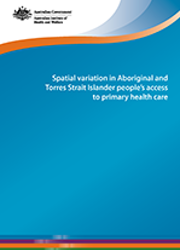Summary
This report presents the findings of work undertaken to map access to primary health-care services across Australia relative to the distribution of Aboriginal and Torres Strait Islander people. It focuses primarily on physical access to Indigenous-specific primary health-care services funded by the Australian Government (referred to hereafter as ISPHCS) and also takes into account Indigenous people's access to GPs in general and to hospitals.
The report includes maps and analyses that identify areas where critical service gaps exist for Aboriginal and Torres Strait Islander people with respect to their access to primary health care. It also examines the types of services provided by ISPHCS, with a specific focus on maternal health services and diabetes management.
Key findings
- In 2012-13, 219 organisations that reported to the Online Services Reporting (OSR) and/or to the national Key Performance Indicator (nKPI) data collections were funded by the Australian Government to provide primary health-care services at 323 locations.
- Areas classified as Remote and Very remote in the Australian Bureau of Statistics' Australian Statistical Geography Standard have the most ISPHCS locations per 1,000 Aboriginal and Torres Strait Islander people. However, these areas also have the highest proportion of Aboriginal and Torres Strait Islander people needing to travel more than 1 hour to access the nearest ISPHCS.
- There are a number of areas with very limited access to both ISPHCS and to all GPs (referred to as 'service gap areas'). Forty SA2s (Statistical Areas Level 2) were identified as service gap areas with no ISPHCS locations within 1 hour's drive and with poor access to GP services in general (including services provided by the Royal Flying Doctor Service).
- 10 service gap areas have Aboriginal and Torres Strait Islander populations of at least 600; 4 of these areas (the Torres Strait Islands, Torres and Central Highlands East in Queensland, and Ashburton in Western Australia), have Aboriginal and Torres Strait Islander populations of more than 1,200 (excludes Palm Island in Queensland which has recently had a new GP clinic opened).
- The remaining service gap areas have Aboriginal and Torres Strait Islander populations ranging from fewer than 50 to close to 600.
- 61% of the service gap SA2s have high rates of potentially preventable hospitalisations.
- Examination of GP services that were not part of the OSR or nKPI data collections-for example, state-funded services and very new services with GPs not included in the Access Relative to Need (ARN) index-revealed an additional 17 primary health-care services inside service gap SA2s or in adjacent SA2s. These additional services improved access significantly in 3 of the 40 identified service gap areas (Palm Island in Queensland; Tasmania's West Coast; and Exmouth in Western Australia).
- Access to primary health care in service gap areas may also be influenced by state- funded primary health-care services without permanent GPs. For example, the Torres Strait Islands SA2 has a number of such services funded by Queensland Health.
Preliminary material: Acknowledgments; Abbreviations; Preface
1 Introduction
2 Methods
3 Findings
- Geography of primary health-care services
- Service gap areas
- Maternal and child health
- Diabetes management
4 Conclusion
Appendixes
Appendix A: Additional findings and background
Appendix B: Data sources, quality and limitations
Appendix C: Detailed notes on methodology
End matter: References; List of tables; List of figures; List of maps



